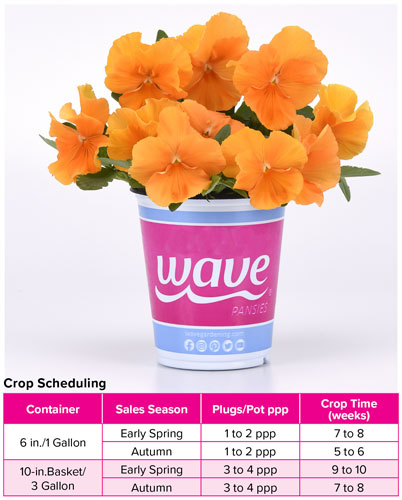4/1/2025
Go Straight to the Top
Robin Ruether
In 2025, the pink pot plant brand known for its easy, spreading color is celebrating 30 years in the industry. For three decades now, Wave Petunias have been a staple in greenhouses and home gardens. The launch of Wave Pansies in 2012 extended these carpets of color into the cooler months for shoulder season sales. And, now, in this milestone year, breeder PanAmerican Seed announces a big-sister addition to the existing Cool Wave Pansy series.
Meet Top Wave
In March, new Top Wave Spreading Pansy debuted to the industry with eight varieties at California Spring Trials. The series also had a consumer preview at this year’s Philadelphia Flower Show as a showcase plant in the daily Potting Parties of floral designer Tu Bloom. That means thousands of people already have been introduced to Top Wave! As the largest-flowered spreading pansy on the market, this series deserved to make a big entrance.
Top Wave differs from the Cool Wave series with 25% bigger blooms. Its nicely mounded shape at point-of-sale beats the competition for visual shopper appeal, and once established, the gardener gets a vigorously trailing plant (20- to 30-in./51- to 76-cm spread). For shoulder sales, it’ll be your top choice for premium pots, baskets or mixed seasonal containers. Top Wave also creates a colorful, low-maintenance landscape design, as it’s faster to fill than standard pansies and the flower color rests “on top” of the plant.
Production is straightforward for Top Wave Pansy, and growers will appreciate this upgrade to plant structure and leaf shape, which helps it disguise all the branching as you approach shipping. Here are a few production guidelines to help you produce the best-looking Top Wave Pansies.
Germination & plug production
Top Wave Pansy seed is primed. Sow 1 seed per cell in a 288 plug size. Seed germinates at 64 to 77F (18 to 25C) and takes two to three days. Covering the seed is optional and light is also optional for germination. Maintain media pH at 5.5 to 5.8 and EC of 0.75 mmhos/cm during plug production. Keep moisture high at Level 4 until radicle emergence.
During Stage 2, lower moisture levels slightly to Level 3 to 4 and provide temperatures of 64 to 70F (18 to 21C). For light, aim for 2,500 f.c. (26,900 Lux). Apply fertilizer less than 100 ppm N, less than 0.7 EC. Maintain the same temperatures, moisture and light levels during Stage 3. Fertilizer should be applied at 100 to 175 ppm N (0.7 to 1.2 EC). A daminozide spray at 1,500 to 2,500 ppm can be applied to control growth.
In Stage 4, decrease your moisture to a Level 2 to 4 and decrease temperature slightly to 60 to 65F (16 to 18C). Increase light to 5,000 f.c. (53,800 Lux). Another daminozide spray at the same rate can be applied in Stage 4 for growth control as well.
Finishing key tips
To control plant growth in the north for early spring sales, use one to two applications of daminozide/chlormequat chloride tank mix 5,000/500 ppm spray on 6-in. pots; use a 2,500/250 to 300 ppm spray for larger 10-in. basket sizes. In warmer conditions, add more frequencies.
Temperatures for finishing
Day: 62 to 70F (17 to 21C)
Night: 55 to 60F (13 to 16C)
The target media pH should be 5.5 to 5.8 with an EC of 1.2-1.5 mmhos/cm. After transplant, apply fertilizer at a rate of 175 to 225 ppm N.
To help growers promote and sell Wave Pansies, new packaging and marketing materials have been developed for printing on-demand or placing an order through packaging suppliers. In addition, consumer buzz will further engage the shopper with ongoing brand support on social media through the new National Wave Day Holiday (May 3) and public outreach.
The continuous improvements to the Wave brand show how much potential this category of easy, spreading color has for the greenhouse industry. Even with 30 years under its belt, Wave is growing! PanAmerican Seed is pleased to launch new opportunities like Top Wave for shoulder season sales within a brand that has so much to celebrate. GT
Robin Ruether is a senior product manager for PanAmerican Seed in the Guadalupe, California, breeding station. She builds plant culture guidelines for easy grower production. Visit panamseed.com for full GrowerFacts, research documents and resources.